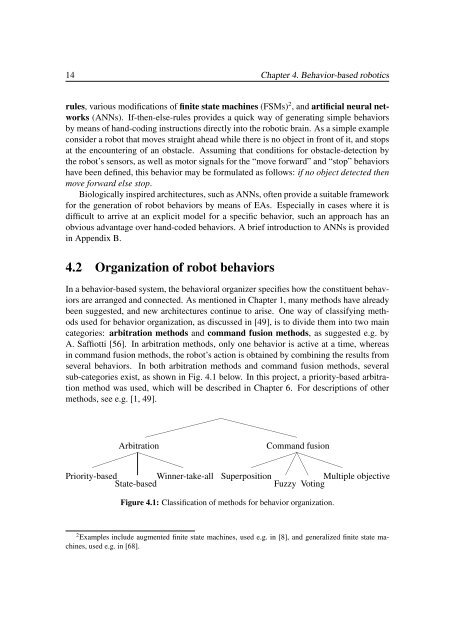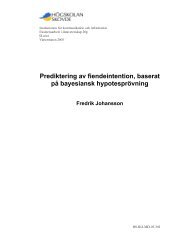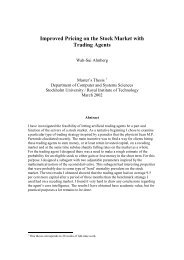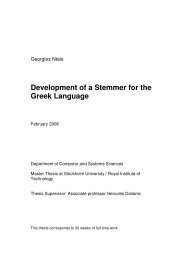Modeling Hydra Behavior Using Methods Founded in Behavior-Based Robotics
Modeling Hydra Behavior Using Methods Founded in ... - SAIS
Modeling Hydra Behavior Using Methods Founded in ... - SAIS
You also want an ePaper? Increase the reach of your titles
YUMPU automatically turns print PDFs into web optimized ePapers that Google loves.
14 Chapter 4. <strong>Behavior</strong>-based roboticsrules, various modifications of f<strong>in</strong>ite state mach<strong>in</strong>es (FSMs) 2 , and artificial neural networks(ANNs). If-then-else-rules provides a quick way of generat<strong>in</strong>g simple behaviorsby means of hand-cod<strong>in</strong>g <strong>in</strong>structions directly <strong>in</strong>to the robotic bra<strong>in</strong>. As a simple exampleconsider a robot that moves straight ahead while there is no object <strong>in</strong> front of it, and stopsat the encounter<strong>in</strong>g of an obstacle. Assum<strong>in</strong>g that conditions for obstacle-detection bythe robot’s sensors, as well as motor signals for the “move forward” and “stop” behaviorshave been def<strong>in</strong>ed, this behavior may be formulated as follows: if no object detected thenmove forward else stop.Biologically <strong>in</strong>spired architectures, such as ANNs, often provide a suitable frameworkfor the generation of robot behaviors by means of EAs. Especially <strong>in</strong> cases where it isdifficult to arrive at an explicit model for a specific behavior, such an approach has anobvious advantage over hand-coded behaviors. A brief <strong>in</strong>troduction to ANNs is provided<strong>in</strong> Appendix B.4.2 Organization of robot behaviorsIn a behavior-based system, the behavioral organizer specifies how the constituent behaviorsare arranged and connected. As mentioned <strong>in</strong> Chapter 1, many methods have alreadybeen suggested, and new architectures cont<strong>in</strong>ue to arise. One way of classify<strong>in</strong>g methodsused for behavior organization, as discussed <strong>in</strong> [49], is to divide them <strong>in</strong>to two ma<strong>in</strong>categories: arbitration methods and command fusion methods, as suggested e.g. byA. Saffiotti [56]. In arbitration methods, only one behavior is active at a time, whereas<strong>in</strong> command fusion methods, the robot’s action is obta<strong>in</strong>ed by comb<strong>in</strong><strong>in</strong>g the results fromseveral behaviors. In both arbitration methods and command fusion methods, severalsub-categories exist, as shown <strong>in</strong> Fig. 4.1 below. In this project, a priority-based arbitrationmethod was used, which will be described <strong>in</strong> Chapter 6. For descriptions of othermethods, see e.g. [1, 49].✘ ✘ ✘ ✘✘ ✘ ✘✘ ✘ ✘❳ ❳ ❳ ❳❳❳ ❳❳❳ ❳ArbitrationCommand fusion ✏ ✏ ✏✏✏✏✏ ✏ ✏✏✏✏ ✁❆✁ ❆✁Priority-based W<strong>in</strong>ner-take-all Superposition ❆Multiple objectiveState-based Fuzzy Vot<strong>in</strong>gFigure 4.1: Classification of methods for behavior organization.2 Examples <strong>in</strong>clude augmented f<strong>in</strong>ite state mach<strong>in</strong>es, used e.g. <strong>in</strong> [8], and generalized f<strong>in</strong>ite state mach<strong>in</strong>es,used e.g. <strong>in</strong> [68].





